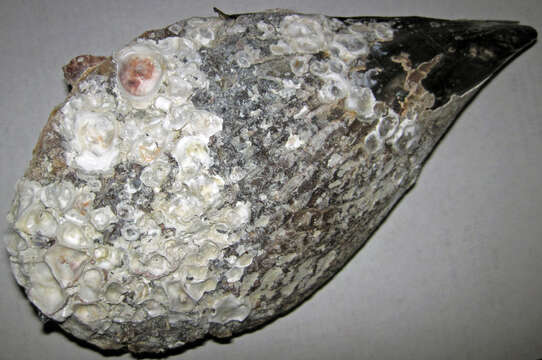Atrina pen shell bivalve with encrusting Crassostrea virginica oysters (Sanibel Island, Florida, USA) 2

Description:
Description: English: Atrina pen shell bivalve shell with encrusting oysters from Florida, USA. Bivalves are bilaterally symmetrical molluscs having two calcareous, asymmetrical shells (valves) - they include the clams, oysters, and scallops. In most bivalves, the two shells are mirror images of each other (the major exception is the oysters). They occur in marine, estuarine, and freshwater environments. Bivalves are also known as pelecypods and lamellibranchiates. Bivalves are sessile, benthic organisms - they occur on or below substrates. Most of them are filter-feeders, using siphons to bring in water, filter the water for tiny particles of food, then expel the used water. The majority of bivalves are infaunal - they burrow into unlithified sediments. In hard substrate environments, some forms make borings, in which the bivalve lives. Some groups are hard substrate encrusters, using a mineral cement to attach to rocks, shells, or wood. The fossil record of bivalves is Cambrian to Recent. They are especially common in the post-Paleozoic fossil record. The large shell shown above is a pen shell, Atrina sp. This is the exterior surface of a right valve. Atrina bivalves are known in the fossil record - their reported age range is Triassic to Holocene. Atrina shells are thin, moderately fragile, and relatively organic-rich (Atrina shells can be partially dissolved by the dilute bleach that is used to clean these and eliminate foul odors). The interior surfaces of individual Atrina shells have some attractive, rainbow-iridescent nacreous aragonite. Much of the pen shell's surface is obscured by dozens of encrusting oysters. Oysters are sessile, benthic, filter-feeding bivalves that cement one of their shells to hard substrates, such as rock, wood, or shells. The upper (non-cemented) valve of each of these encrusting oysters is now gone. Classification: Animalia, Mollusca, Bivalvia, Pteriomorphia, Pterioida, Pinnidae Locality: marine beach along the southern shoreline of Sanibel Island, southwestern Florida, USA. Date: 24 November 2016, 17:18:27. Source: https://www.flickr.com/photos/47445767@N05/30876898450/. Author: James St. John.
Included On The Following Pages:
- Life (creatures)
- Cellular (cellular organisms)
- Eukaryota (eukaryotes)
- Opisthokonta (opisthokonts)
- Metazoa (Animal)
- Bilateria
- Protostomia (protostomes)
- Spiralia (spiralians)
- Mollusca (molluscs)
- Bivalvia (mussels)
- Autobranchia
- Pteriomorphia
- Ostreida
- Pinnoidea
- Pinnidae
- Atrina
This image is not featured in any collections.
Source Information
- license
- cc-by-3.0
- copyright
- James St. John
- creator
- James St. John
- source
- James St. John (47445767@N05)
- original
- original media file
- visit source
- partner site
- Wikimedia Commons
- ID


